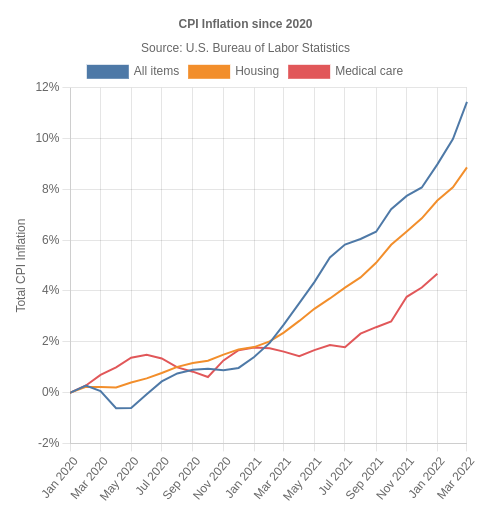Get inflation updates
Stay up-to-date with the latest inflation numbers once per month.
Powered by EmailOctopus

According to the U.S. Bureau of Labor Statistics, prices for meats were 49.67% higher in 2020 versus 2004 (a $9.93 difference in value).
Between 2004 and 2020: Meats experienced an average inflation rate of 2.55% per year. This rate of change indicates significant inflation. In other words, meats costing $20 in the year 2004 would cost $29.93 in 2020 for an equivalent purchase. Compared to the overall inflation rate of 1.99% during this same period, inflation for meats was higher.
In the year 2004: Pricing changed by 8.41%, which is significantly above the average yearly change for meats during the 2004-2020 time period. Compared to inflation for all items in 2004 (2.68%), inflation for meats was much higher.
Below are calculations of equivalent buying power for Meats, over time, for $20 beginning in 2004. Each of the amounts below is equivalent in terms of what it could buy at the time:
| Year | USD Value | Inflation Rate |
|---|---|---|
| 2004 | $20.00 | 8.41% |
| 2005 | $20.47 | 2.37% |
| 2006 | $20.61 | 0.68% |
| 2007 | $21.29 | 3.26% |
| 2008 | $22.03 | 3.50% |
| 2009 | $21.89 | -0.63% |
| 2010 | $22.52 | 2.84% |
| 2011 | $24.50 | 8.83% |
| 2012 | $25.33 | 3.36% |
| 2013 | $25.63 | 1.21% |
| 2014 | $28.00 | 9.24% |
| 2015 | $28.85 | 3.03% |
| 2016 | $27.57 | -4.43% |
| 2017 | $27.41 | -0.58% |
| 2018 | $27.52 | 0.41% |
| 2019 | $27.88 | 1.30% |
| 2020 | $29.93 | 7.38% |
| 2021 | $32.23 | 7.66% |
| 2022 | $34.87 | 8.20% |
| 2023 | $35.59 | 2.07% |
| 2024 | $36.61 | 2.85% |
| 2025 | $37.35 | 2.04%* |
* Not final. See inflation summary for latest details.
** Extended periods of 0% inflation usually indicate incomplete underlying data. This can manifest as a sharp increase in inflation later on.
Raw Consumer Price Index data from U.S. Bureau of Labor Statistics for Meats:
| Year | 1935 | 1936 | 1937 | 1938 | 1939 | 1940 | 1941 | 1942 | 1943 | 1944 | 1945 | 1946 | 1947 | 1948 | 1949 | 1950 | 1951 | 1952 | 1953 | 1954 | 1955 | 1956 | 1957 | 1958 | 1959 | 1960 | 1961 | 1962 | 1963 | 1964 | 1965 | 1966 | 1967 | 1968 | 1969 | 1970 | 1971 | 1972 | 1973 | 1974 | 1975 | 1976 | 1977 | 1978 | 1979 | 1980 | 1981 | 1982 | 1983 | 1984 | 1985 | 1986 | 1987 | 1988 | 1989 | 1990 | 1991 | 1992 | 1993 | 1994 | 1995 | 1996 | 1997 | 1998 | 1999 | 2000 | 2001 | 2002 | 2003 | 2004 | 2005 | 2006 | 2007 | 2008 | 2009 | 2010 | 2011 | 2012 | 2013 | 2014 | 2015 | 2016 | 2017 | 2018 | 2019 | 2020 | 2021 | 2022 | 2023 | 2024 | 2025 |
| CPI | 12.454 | 12.192 | 13.162 | 12.085 | 11.954 | 11.669 | 13.177 | 15.162 | 15.354 | 14.600 | 14.600 | 18.654 | 26.562 | 30.169 | 28.362 | 29.931 | 33.900 | 33.577 | 31.354 | 31.208 | 28.708 | 27.785 | 30.823 | 34.300 | 33.077 | 32.485 | 32.900 | 33.546 | 33.000 | 32.523 | 34.977 | 38.238 | 37.231 | 38.085 | 41.523 | 43.785 | 43.485 | 48.123 | 59.985 | 61.131 | 66.246 | 66.369 | 64.908 | 77.015 | 90.100 | 92.662 | 96.023 | 100.654 | 99.508 | 99.838 | 98.885 | 101.992 | 109.646 | 112.185 | 116.700 | 128.454 | 132.538 | 130.654 | 134.631 | 135.354 | 135.469 | 140.154 | 144.362 | 141.631 | 142.323 | 150.723 | 159.300 | 160.269 | 168.985 | 183.192 | 187.538 | 188.823 | 194.983 | 201.815 | 200.545 | 206.232 | 224.439 | 231.981 | 234.778 | 256.469 | 264.232 | 252.521 | 251.048 | 252.076 | 255.341 | 274.178 | 295.191 | 319.398 | 326.000 | 335.289 | 342.121 |